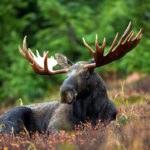The coyote, a close relative of the grey wolf and several other varieties of a wolf, is native to the continent of North America. All good and dandy, but a coyote attack is the stuff of nightmares, so let’s see how to avoid one and survive one so you can tell the story of your latest hiking adventure…
Though smaller than a wolf, an adult male coyote can weigh up to fifty pounds. Coyotes prefer to live in woods, grasslands, or mountainous areas, but they are extremely versatile animals and have been sighted in well-populated urban areas.
Chances are you won’t encounter a coyote while hiking or camping (or while going about your business in any of the urban areas where they’ve been spotted). It is more likely to encounter a wolf or a wild boar in your travels and adventures, so you should prepare yourself for such encounters of the third kind as well.
Coyotes generally hunt rodents and other small animals, and while they have been known to hunt during the day, they usually do so at night. They are wily and opportunistic hunters, but they generally steer clear of humans, even when hunting in packs.
Still, it’s always a good idea to be prepared in the unlikely event you should come across a coyote on your next hiking or camping trip. As with most wild animals, there are certain behaviors that may increase the likelihood of an encounter and potentially, of an attack. For more information on surviving animal attacks and living to tell the story, here is our full guide on how to survive an animal attack.
 How to Avoid and Survive a Snake Attack - Snakes aren’t as dangerous as one would think, especially if you know how to handle them.
How to Avoid and Survive a Snake Attack - Snakes aren’t as dangerous as one would think, especially if you know how to handle them.

How To Avoid A Coyote Attack
safely
Make Noise
Because coyotes tend to avoid humans, the best way to prevent an encounter is to avoid accidentally surprising one. Be sure to make a bit of noise as you hike through dense brush so you don’t catch a coyote, or another potentially dangerous wild animal, unawares. Don’t hike at night, as this is when coyotes are most likely to be active.
Keep Your Dog on a Leash
If you’ve ever wondered, “will a coyote attack a dog?” the short answer is yes. If you plan to bring your four-legged friend/s camping or hiking with you, be sure to keep him on a very short leash as you explore your surroundings. Most coyote attacks involving humans have been the result of attacks on pets in which the owner tried to intervene. According to the Urban Coyote Research, the best way to deal with a coyote attack that somehow involves your pet is as follows:
Coyotes probably live nearby, even if you don’t know it, so do not let pets run loose. When hiking in parks, keep dogs on leashes. Pets left outside, even with fencing, remain at risk for predation and unnecessary conflict. Do not leave your pets unattended outside, not even for a second. Remember, electric fences may keep your pets contained but do not keep other animals away.
Don’t Keep Food Around Your Tent
Be sure not to leave any food, or trash containing food outside your tent or around your campsite. Doing so may attract not only coyotes but bolder and more potentially dangerous wild animals. And, no matter what you do or how much food you have left, never let your leftovers out for the coyotes, nor try to feed them ever.

How To Survive A Coyote Encounter
to tell the tale
Should you come across a coyote on your hike or camping trip, the most important thing to do is never turn your back on it. Also, don’t attempt to run from a coyote. A coyote can run at an average speed of forty-two miles an hour, far faster than the average human can.
Instead, stand your ground and maintain eye-contact with the animal. Unlike bears, wolves, and mountain lions, coyotes can be intimidated, and most times simply standing your ground will be enough to send the coyote on its way.
 How to Survive a Moose Attack While Hiking - Moose attacks are more common than you would think. Remember, you should always be prepared for any situation.
How to Survive a Moose Attack While Hiking - Moose attacks are more common than you would think. Remember, you should always be prepared for any situation.
A coyote that has become accustomed to humans, or who is establishing a family during mating season, might be less easily scared off and therefore potentially more dangerous. If standing your ground and maintaining eye-contact doesn’t intimidate the coyote, flail your arms and make noise.
In the extremely unlikely event that the animal still stands its ground, find something to throw at it.
Should all this fail and a coyote actually attacks you, your best chance is to fight back. Don’t play dead, as this may only encourage the opportunistic hunter.

Times a Coyote Encounter/Attack
is more likely
While attacks on humans by coyote are rare, confrontations with and/or attacks by coyotes are more likely to occur in the months of January and February.
Already lean months for hunting food, they also happen to be the coyote’s mating season. Like most animals, coyotes are most dangerous to humans when they believe their pups to be in danger. Never, ever, get between a wild animal and its young.
Songs and Vocalizations
you need to know
Though you’re unlikely to encounter a coyote on your hike or camping trip, you’re very likely to hear one, or even a chorus of them after sundown. The yipping and howling that’s led the coyote to be dubbed the “song dog” is often misinterpreted, though.
Many people mistake them for coyote attack sounds, but experts believe coyotes yip and howl in order to communicate with one another and to establish territory.
Jackal vs Coyote
What’s the difference?

For a long time, the term “Jackal” was used to describe a number of small canids (mammals of the genus Canis like wolves and coyotes.) Because of this, and because the coyote is sometimes referred to as the “American Jackal,” there remains some confusion as to the difference between the two animals.
In modern usage, the name “Jackal” refers specifically to three species of canid:
- the Black-Backed Jackal;
- the Side-Striped Jackal – both of which are native to the African continent;
- the Golden Jackal – a canid indigenous to Eurasia.
Jackals are about the size of the red fox, which is roughly half the size of a coyote.
The majestic mountain ranges and lush woodlands of North America make for some of the best hiking and camping to be had in the world.
The various wildlife indigenous to the area only makes the experience that much more rich and enjoyable…as long as one is prepared for a possible encounter.
Different rules apply when it comes to handling encounters with different animals, and it’s important to educate yourself on any and all wild animals you may encounter where you are planning to hike or camp.
Understanding the signs of aggression, and knowing how to react to a potential attack, can be the difference between survival and serious injury or even death.
 How to Survive an Animal Attack | Complete Hikers’ Guide + Infographic - Safety above all! Learn how you should respond to a wildlife encounter with our easy and fun guide.
How to Survive an Animal Attack | Complete Hikers’ Guide + Infographic - Safety above all! Learn how you should respond to a wildlife encounter with our easy and fun guide.
Surviving a Coyote Attack: Frequently Asked Questions
Before we leave you to your packing for your next trip, let’s answer some of the most frequently asked questions regarding a coyote attack and how to avoid it or survive the encounter so your hiking story does not turn into a creepy backpacking legend kids tell around the fire.
1. Will a coyote attack a human?
Coyotes are wary of people and will not attack out of the blue. However, one of the main issues is whether a coyote will attack a human walking a dog. In this case, if the dog is without a leash, things might get heated very fast. It is best to keep your dog as close to you as possible, as a coyote attack is not likely if you have your pet close.
2. What should you do if you encounter a coyote?
First of all, don’t run, just as you shouldn’t run if you encounter a wolf in your hiking adventures. Running is very likely to trigger the hunters within these animals and it is best for you to avoid being chased down by a killer predator. Instead, stand tall and assertive, looking as menacing as you can. Maintain eye contact with the coyote and do not turn your back at it for any reason. Try to scare it away by making yourself bigger than it is (rise and wave your arms) and make a lot of noise.
3. Do coyotes kill quickly?
This is a problem with coyotes in urban or rural settings attacking deer, small animals, sheep, or dogs. It is unlikely to meet coyotes so fierce to kill humans while they hike, but it is better to be safe than sorry. To kill animals quickly, coyotes bite the animal’s throat in the area under the ears but behind the jaw. You should always keep your dog safe while hiking in the wilderness, as small pets often fall prey to coyotes. Normally, they consider big dogs as rivals, so you don’t want to encourage a fight no matter how much trust you put into your faithful large companion.
Surviving a Coyote Attack: Conclusion
Should you encounter a coyote on your next hiking or camping excursion, remember never to turn your back on the creature. Even a coyote that’s grown accustomed to people can usually be frightened off by intimidating gestures and/or loud noises. Be sure to keep your pets leashed. Oh, and if you hear coyotes yipping and howling in the night as you zip yourself into your sleeping bag, relax. You aren’t being plotted against, and it isn’t a war-cry, so just chill out and enjoy the eerie, yet somehow beautiful serenade. Avoiding and living through a coyote attack unscathed is likelier and easier in comparison to other more dangerous predators, but it does not mean you can wing it. Always be ready, no matter where you hike!





